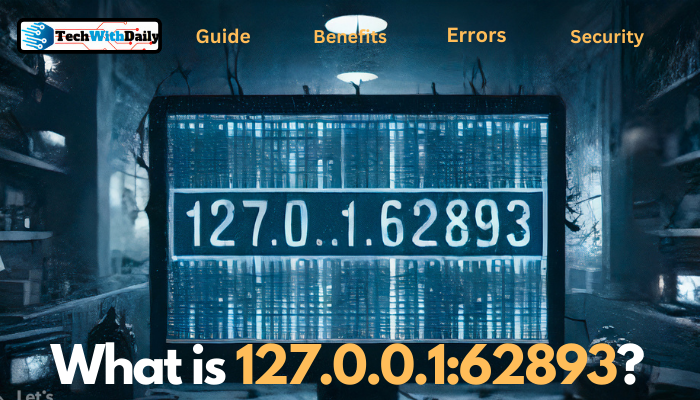127.0.0.1:62893 Guide: Errors, Fixes, and Best Practices
Have you ever seen an address like 127.0.0.1:62893 and wondered what it means? This address is a way for your computer to talk to itself, often used during testing and development.
In this guide, we’ll break down what 127.0.0.1:62893 really is and how it works. We’ll explore common problems you might run into, how to fix them, and some tips to use it effectively. Whether you’re new to this or just need a refresher, we’ll help you understand and handle these addresses with ease. Let’s get started and make sense of it all!
Understanding 127.0.0.1:62893
What is 127.0.0.1:62893?
The term 127.0.0.1:62893 combines an IP address and a port number. 127.0.0.1 is the loopback address, often referred to as ‘localhost,’ used to test network applications on your own device without sending data over the internet. Port 62893 is a specific gateway that allows services to communicate with your machine. This combination is commonly used in local network testing, software development, and accessing services like web servers from your browser.
Benefits of Using 127.0.0.1:62893
- Advantages for Developers
Using 127.0.0.1:62893 offers developers a safe environment to test their applications locally. This setup enables debugging and testing of web applications or APIs without exposing them to the external internet, ensuring security and ease of troubleshooting.
- Security Aspects
127.0.0.1:62893 enhances security by limiting access to the local machine. Since the loopback address doesn’t connect to external networks, it helps in reducing the risk of unauthorized access and data breaches during development or testing.
- Network Troubleshooting
This configuration is also useful for diagnosing network issues. Developers can simulate network conditions and resolve potential problems before deploying their applications on a live server, ensuring smoother operation.
Is it Safe to Expose Port 62893 Publicly?
Risks and Mitigations
Exposing port 62893 publicly can introduce several security risks. Attackers might exploit open ports to gain unauthorized access or launch attacks like Denial of Service (DoS). Since 127.0.0.1 is meant for local use, exposing it alongside an open port could make your system vulnerable to cyber threats, especially if proper security measures aren’t in place.
Safe Practices for Port Exposure
To mitigate risks, it’s crucial to follow best practices when exposing ports like 62893. Use strong firewall rules to restrict access only to trusted IP addresses. Implement encryption protocols and regularly update your software to patch any vulnerabilities. Additionally, avoid exposing ports publicly unless absolutely necessary, and always monitor network traffic for suspicious activity.
Related: What Does This Code Mean b88221141
Troubleshooting Errors Related to 127.0.0.1:62893
Common Errors and Their Fixes
Disconnected from the target VM, address: 127.0.0.1:62893″ Error
This error usually occurs when there is a communication issue between the local machine and the virtual machine (VM). To fix it, ensure that the VM is running and the correct port is being used. Restarting the VM or checking the network settings can also resolve the issue.
Port Conflicts and How to Resolve Them
Port conflicts happen when port 62893 is being used by another application. To resolve this, identify the conflicting application using tools like Netstat and reassign it to a different port. Alternatively, configure your application to use a different, unused port.
Firewall and Security Software Interference
Sometimes, firewalls or security software block traffic to port 62893. To fix this, add an exception for 127.0.0.1:62893 in your firewall or security software settings. Ensure that only the necessary traffic is allowed while keeping other potential threats blocked.
Advanced Troubleshooting Tips
- Network Configuration Adjustments
Adjusting network configurations can resolve more complex issues with 127.0.0.1:62893. This might involve tweaking your router settings, updating network drivers, or modifying your system’s hosts file to ensure proper routing of traffic through the loopback address.
- Debugging in a Development Environment
For developers, debugging tools like integrated development environments (IDEs) can help identify issues related to 127.0.0.1:62893. Using these tools, you can step through your code, inspect variables, and monitor network traffic to pinpoint the root cause of any problems.
Maintaining Security When Using 127.0.0.1:62893

Protecting Against Unauthorized Access
Even though 127.0.0.1 is a loopback address, maintaining strong security practices is essential. Use robust authentication methods for any services running on port 62893. Regularly update passwords, implement multi-factor authentication (MFA), and ensure that only authorized users have access.
Regular Monitoring and Updates
Regularly monitor the traffic on 127.0.0.1:62893 to detect any unusual activity. Keep your software and security patches up to date to minimize the risk of vulnerabilities being exploited. Automated monitoring tools can alert you to potential security threats in real time.
When to Seek Expert Help
Persistent Issues
If you encounter persistent issues with 127.0.0.1:62893 that you cannot resolve, it may be time to seek expert assistance. Networking professionals can provide advanced troubleshooting, ensuring that your system is configured correctly and securely.
Advanced Network Configurations
When dealing with complex network configurations or deploying applications in a production environment, expert guidance can help avoid common pitfalls. Professionals can ensure that your system is optimized for performance and security, reducing the risk of errors and vulnerabilities.
How 127.0.0.1:62893 Works
The Role of 127.0.0.1 in Networking
127.0.0.1 is known as the loopback address, a special IP address used by the device to refer to itself. It is crucial for testing network services locally, enabling developers to interact with applications on their machines without sending traffic outside.
Port 62893: What It Does
Port 62893 is one of the many ports available on a computer used for various services. In this case, it acts as a doorway through which data can flow between the local machine and the application being tested, allowing for efficient data exchange and service accessibility.
Common Applications and Use Cases
Software Development and Debugging
In software development, 127.0.0.1:62893 is often used to run applications locally before moving them to a production environment. This allows developers to catch bugs and errors in a controlled setting, reducing the chances of issues in the final product.
Accessing Local Services
Web servers, databases, and other services can be accessed locally using 127.0.0.1:62893. This is especially useful for testing how these services interact with each other on the same machine without external interference.
Security Considerations
While using 127.0.0.1:62893 is secure within the local environment, it’s essential to be aware of potential risks if the services are exposed to external networks. Proper firewall settings and security practices should be in place to prevent unauthorized access.
Conclusion: Maximizing the Use of 127.0.0.1:62893
Throughout this guide, we’ve explored the intricacies of 127.0.0.1:62893, from understanding its basic components to addressing security and troubleshooting issues. We’ve highlighted the significance of the loopback address 127.0.0.1 in local testing, the critical role of port 62893 in facilitating communication, and the importance of maintaining security when exposing this port.
Additionally, we discussed common errors, their resolutions, and provided advanced troubleshooting tips for those encountering persistent issues.
Recommendations
To fully leverage 127.0.0.1:62893, it’s essential to follow best practices. Always prioritize security by limiting port exposure, using strong authentication methods, and keeping your systems updated.
Regular monitoring is crucial to detect and mitigate potential risks early. For developers, using 127.0.0.1:62893 as a testing and debugging tool can significantly streamline your workflow, but always ensure that configurations are optimized and errors are promptly addressed.
If you encounter challenges beyond your expertise, seeking professional help is advisable to ensure your setup remains secure and efficient.
FAQs
1. What does 127.0.0.1:62893 represent in networking?
127.0.0.1:62893 refers to a local host connection on port 62893, allowing your computer to communicate with itself for testing.
2. Why is 127.0.0.1 used instead of an external IP address?
127.0.0.1 is a loopback address that keeps traffic within your own system, making it ideal for local development and testing.
3. What role does port 62893 play in localhost connections?
Port 62893 is a specific port used to direct traffic within localhost, often selected to avoid conflicts with default service ports.
4. How does 127.0.0.1:62893 enhance security during development?
127.0.0.1:62893 keeps all data on your machine, preventing exposure to external networks, which enhances security during testing.
5. What are the benefits of using 127.0.0.1:62893 for web development?
Using 127.0.0.1:62893 allows developers to test applications locally, simulating real-world environments without the risk of external access.





